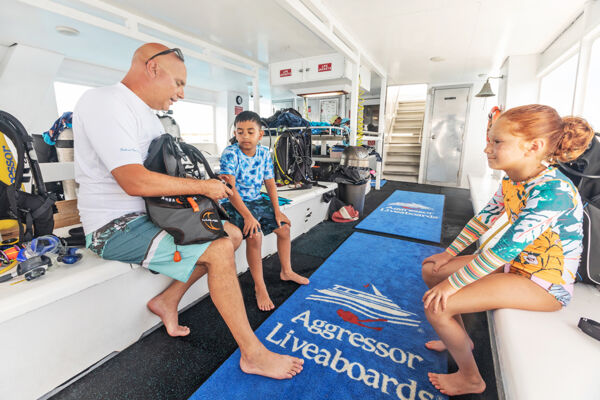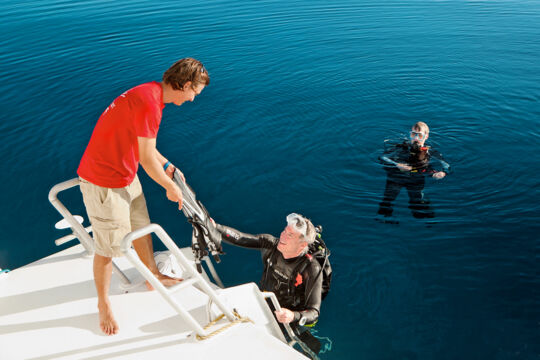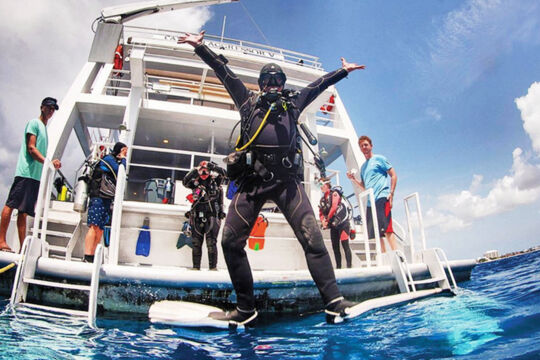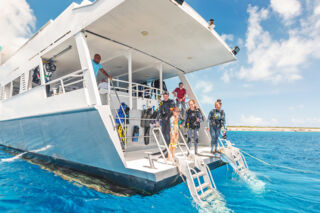Turks and Caicos Liveaboard Diving
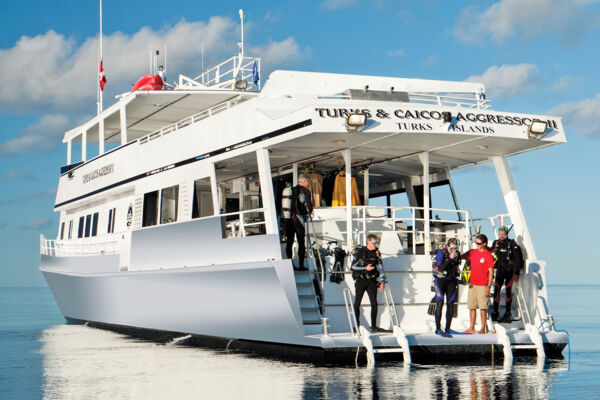
If you want to see the best that the Turks and Caicos reefs have to offer, scuba diving from a liveaboard yacht is a great way to do it.
Liveaboard diving is a type of scuba diving trip that takes place on a large boat over several days. These boats are built or retrofitted for overnight diving trips, with bedrooms, a kitchen and dining area, a diving deck, and everything you need to spend a week or more diving at sea.
Turks and Caicos is an excellent liveaboard diving destination. For North American travelers, it's a far closer alternative to popular liveaboard countries like Indonesia, Thailand, the Maldives, and the Philippines, and offers an abundance of marine life and typically superb diving conditions. The underwater visibility in Turks and Caicos can be as great as 150 feet (46 m).
The average Turks and Caicos liveaboard trip is seven nights. These liveaboards visit sites on the western end of the archipelago, including the west coast of Providenciales, the reefs and wall of the West Caicos Marine National Park, and the surrounding waters of French Cay, a shark diving destination with a vibrant sheer wall.
Liveaboards in the Turks and Caicos depart from Providenciales, which is home to the Providenciales International Airport (PLS).
Liveaboard Diving in Turks and Caicos
There are two international liveaboard companies that operate in the Turks and Caicos Islands: Aggressor Adventures and Explorer Ventures. The Turks and Caicos Aggressor II is a 120-foot (39 m) yacht and liveaboard operated by Aggressor Adventures Liveaboards, which has been offering liveaboard trips to the Turks and Caicos since 1992. Divers on a seven-night trip aboard the Aggressor II complete on average about 27 dives, and visit beautiful sites off of Providenciales, West Caicos, French Cay, and the very remote West Sand Spit.
Why Turks and Caicos Has Great Diving
There are numerous reasons why the Turks and Caicos Islands is an incredible diving destination. Not only does the ocean here boast spectacular visibility, typically calm conditions, and comfortable water temperatures, but it's home to an incredible barrier reef teeming with life. The archipelago's geology also supports excellent wall diving, which occurs at the transition between the shallow Caicos Islands underwater plateau and the deep water that abruptly borders it.
Until fairly recently, few tourists knew about the Turks and Caicos Islands. As such, you won't find crowded dive sites here like you might in other popular scuba diving destinations, such as Thailand and Honduras. Typically, dive sites see only one boat at a time.
Whereas the Turks and Caicos is often considered a Caribbean destination, technically speaking, it's in the North Atlantic (same as the Bahamas).
Common Sightings
Liveaboard divers can spot a range of local marine life, from sharks and turtles to stingrays, eagle rays, barracuda, moray eels, nudibranchs, lobsters, angelfish, and sometimes even dolphins. The reefs themselves are wonders to behold. You can see branching elkhorn coral, star corals, brain coral, barrel sponges, tube sponges, elephant ear sponges, gorgonian corals, and common sea fans, among others.
Liveaboard Diving vs. Scuba Day Trips
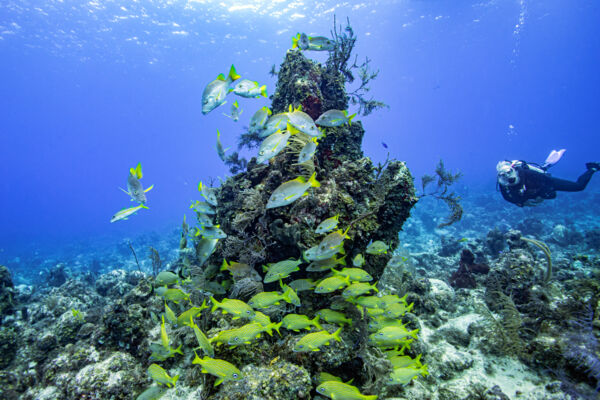
If you want to spend as much time as possible scuba diving on your vacation, a liveaboard is a great choice. Cost per dive will work out cheaper, and—given that the trip is all-inclusive—you won't spend much money day-to-day.
One of the advantages of scuba diving on a liveaboard is the access the boat provides to remote sites throughout the day (such as at night, when many corals tend to feed). Given that most liveaboard boats travel overnight, divers often wake up to find themselves having already arrived at their first site for the day.
Booking a liveaboard trip can also provide you with some pretty spectacular views above the water, such as the starry night sky or the country's magical sunsets.
Turks and Caicos Liveaboard Costs
A one-week scuba diving trip on a Turks and Caicos liveaboard costs between $3,200 and $3,900, tax excluded (2025 prices). The price depends on your accommodation type. A private room with its own shower and toilet, for example, will be more expensive than a bunk room with a shared bathroom.
While booking a liveaboard is a much larger expense than booking a two-tank dive on Providenciales, the experience is great value if you want to do plenty of diving. Given that you can do up to four dives per day and that food, drinks, accommodation, and boat transportation are included, the cost per dive is cheaper.
One of the best ways to save on your liveaboard experience is to book your trip during the low season. September, October, and November are some of the quietest tourism months in the Turks and Caicos, and the liveaboard companies have offered discounts during this time.
What’s Included
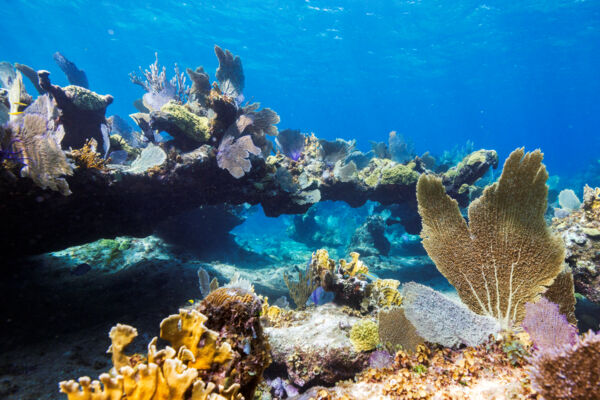
Meals, accommodation, and diving—as well as weights, weight belts, and tank fills—are usually included in Turks and Caicos liveaboard trips. Not included are your gear (BCD, fins, mask, regulator, and wetsuit), taxes, tips, add-ons, and your flights to and from Providenciales. If you don't have your own gear, you can rent equipment on the liveaboards at additional cost.
While liveaboards may include transportation from the airport, this is generally only for same-day arrivals. For a list of popular flight routes to the Turks and Caicos Islands, see Arriving by Air.
If you plan to go diving in the Turks and Caicos, it's highly recommended that you purchase scuba diving insurance, which covers you for diving-related accidents that your typical insurance provider may not insure (as well as lost, stolen, or damaged equipment).
Required Qualifications
Divers must have a PADI Open Water or equivalent certification from a recognized organization to dive on a Turks and Caicos liveaboard. Some liveaboards offer PADI Advanced Open Water training and specialty courses, such as PADI Enriched Air/Nitrox, onboard.
Be sure to bring your certification cards with you. The crew will ask for proof of certification upon check-in.
Not scuba certified yet? Consider getting certified at one of the local dive companies on Providenciales.
Bad Weather
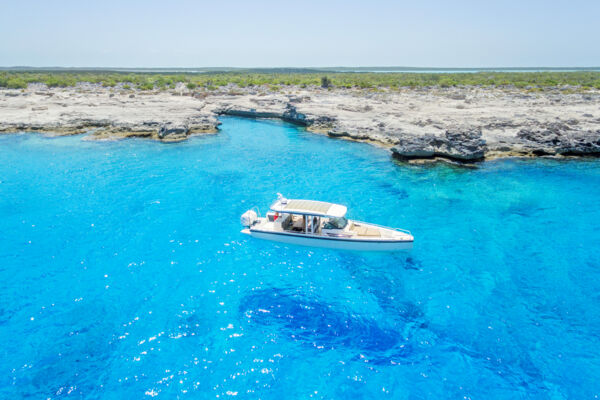
While the Turks and Caicos typically enjoys year-round sun and great weather, the occasional storm or strong wind event can result in a canceled dive.
Some of the scuba diving sites that liveaboard boats visit are weather dependent. The advantage of diving from a liveaboard, however, is that there’s often the option to cruise to an unaffected site nearby or simply wait out the storm.
Safety
All liveaboard yachts generally carry a first-aid kit, oxygen, and an Automated External Defibrillator (AED).
The Turks and Caicos has one hyperbaric (recompression) chamber to treat decompression sickness. It is located on Providenciales.
What to Pack
Pack an underwater camera, or consider purchasing one if you don't have one already. You'll have plenty of opportunities to practice your underwater photography.
Local liveaboards have Type B (the standard US-style plug) electrical outlets. If you’re coming from Europe, South America, or a region that uses another plug type, pack an adaptor.
Visitors from some countries require a visa to enter the Turks and Caicos Islands. For more information on passport validity and visas, see Entry Requirements.
Pack your own scuba diving gear if you have it. This will save you money on equipment rental.
Rough conditions from the odd storm can bring on seasickness—bring sea sickness medication just in case.
All scuba divers should consider purchasing travel insurance and dive insurance before diving in the Turks and Caicos Islands. Organizations such as DAN (Divers Alert Network) provide such policies.
Pack a sweater or long-sleeve shirt to wear onboard, as the air-conditioned indoor spaces can be quite cold.

